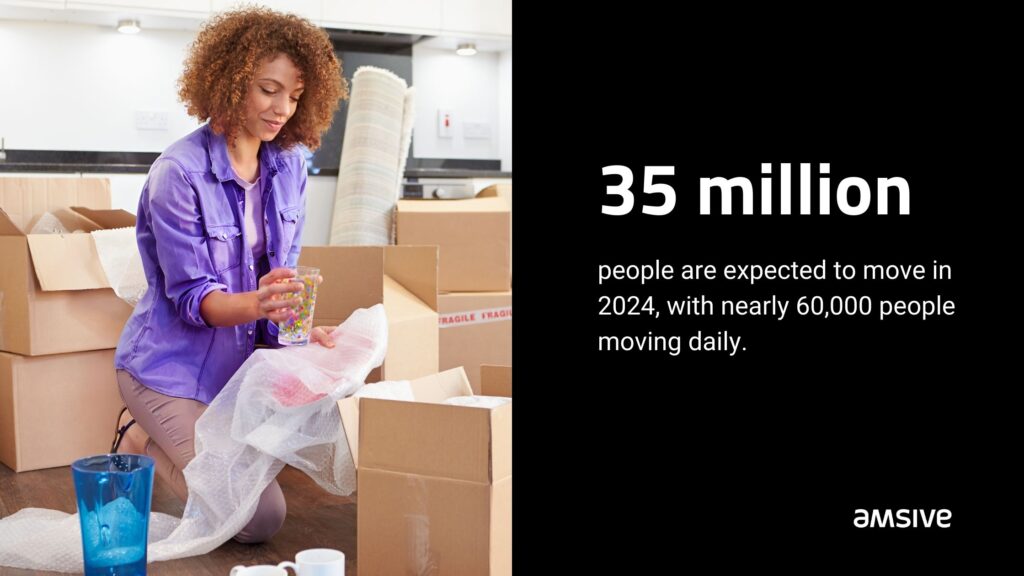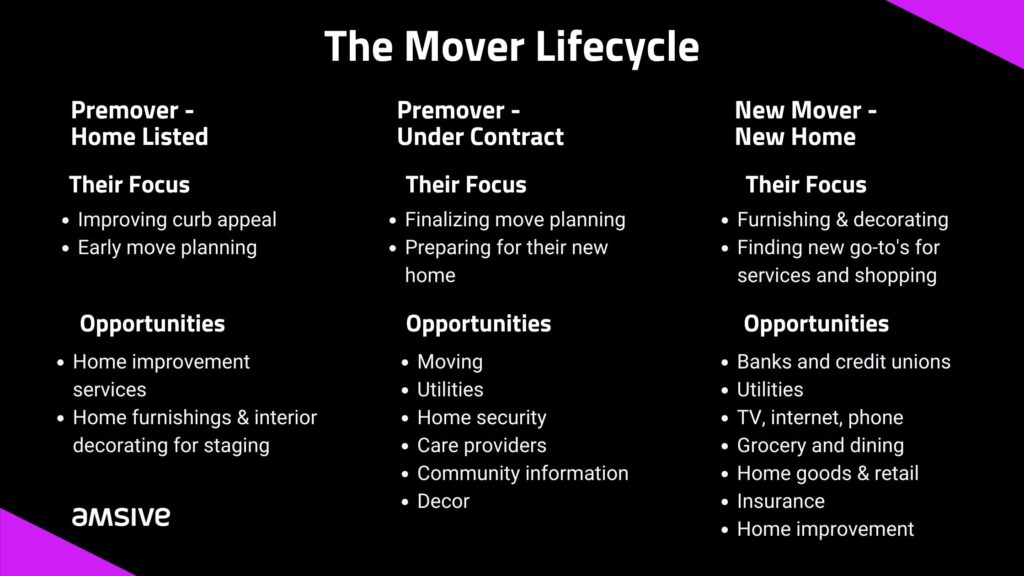An estimated 35 million people will move in 2024, with nearly 60,000 people moving daily. As a segment that spends ~$180 billion in the process of moving, every new move is an opportunity to connect with a new customer. According to Speedeon, on average, movers spend $9,000 over the course of the moving process and are likely to engage with over 70 new brands. Not only are they more likely to switch services like internet, TV, and phone, but they’re more likely to switch the stores that they engage with.
Different needs and decisions arise throughout this stressful transitional period. Marketers have a rare chance to grow their businesses if they can take advantage of it. Within a multichannel strategy, direct mail stands out as consumers are extra conscious of mail during this time. As people change addresses and locations, they may be more likely to pay increased attention to the physical mail that arrives at their new address.

New movers historically have a higher inclination toward switching professional services and institutions, such as financial services and healthcare. They’re also more receptive to shopping with new retailers for things like furniture, electronics, and home improvement products.
With the 2024 USPS postal promotion, which offers large mailers a discount of up to 30%, brands have an opportunity to enhance their multichannel marketing strategy toward a segment of their audience that’s in flux.
To engage consumers as they move, you have to consider the entire lifecycle of the process. They’re a highly dynamic audience whose spending habits change greatly throughout the three phases. In order to reach them effectively, you need to be aware of their state of mind and financial considerations throughout the lifecycle, targeting the right mover with the right message at the right time.
Jump To:
Before moving – home or apartment listed
Premover’s Mindset
Premovers are considered those that have listed their homes or have a home that’s under contract or sold. At this stage, premovers are preparing their homes or apartments for photography, if not for tours. Homeowners looking to sell their homes want to get the best price possible. This will lead premovers to hone in on enhancing or updating their homes in the most strategic way. Whether it’s landscaping, painting, or decluttering rooms, every improvement will help increase overall curb appeal and the perceived value of a home.
At this point in the process, premovers also prepare for the next phase of their move. This can include getting mortgage pre-approval and researching moving-related products and services.
Taking a proactive approach to these tasks will help homeowners streamline their selling process and improve the transition into their new home.
How to reach them
You find people who are pulling up stakes by gathering information from listings of homes for sale. This information is publicly available. You can find this information from USPS’ Change of Address program, Directory Assistance data, lease applications and expirations, rental applications, magazine subscriptions, moving companies, and utility companies, to name a few.
It’s worth noting that while this information can be timely, it’s paramount for marketers to ensure that it’s accurate before they begin their targeting efforts.
Direct mail offers the advantage of precise targeting based on real estate listing and public records, allowing marketers to act in a timely manner. Sending out mailers shortly after a property is listed for sale, or as a sale is pending, can ensure that the message reaches recipients that are actively engaged in the premoving process.
As premovers enter the early stages of the moving process, they may be interested in a variety of services, including home beautification, mortgage pre-approvals, or home improvement loans. Where applicable, offer personalized discount codes or offers.
With 50% of moves occurring within the same town or area, services such as cable and internet have the opportunity to maintain contact and retain customer relationships as they relocate. Send reminders to schedule service for their new home or apartment, offering them the chance to connect as soon as possible.
Targeting during this stage of the premoving process will need to be adjusted as the resident takes the steps to close on a property or move to a new apartment.
While moving – home sold, or lease expired
Mover’s mindset
As movers reach the point at which their home is on offer or their lease has expired, their financial habits and spending will fluctuate. The driving force behind a new move can vary in emotional intensity, from life event changes such as marriage, having children, job switching, first-time home buyers and retirement. The process of moving is multifaceted and can be stressful. During this phase, movers are likely to dive more deeply into making plans for their new home.
Amsive can pinpoint and target movers accurately throughout their journey using data-enriched audience models, ensuring that we’re prioritizing the relevant new movers who are most likely to convert.
How to reach them
The various angles that companies can take to connect with movers during this stage can include:
Packing and organization
There are multiple ways to connect with movers looking for guidance around packing and organization. These can include checklists, guides, or tips for efficient packing, items that may be better sold or discarded, and discounts on packing supplies.
Moving logistics
Use direct mail to offer information about moving companies. This can include quotes for moving, storage facilities, or rental trucks.
Utilities set-up
Target movers that are planning on moving to your area, offering set-up for essentials like electricity, water, gas, internet, or cable.
Home security
Offer movers discounts on home security, smart locks, or surveillance for their new home.
Furniture and decor
New movers spend nearly 50% more on home furnishings than the rest of the population. Provide inspiration, mood boards, and checklists for movers who are preparing to furnish their new living space.
Community information
Whether it’s a map or a short directory, offer movers coming to your area points of interest. These can include neighborhood guides, local businesses, and school district information.
Childcare
In addition to information about school districts, you can also provide local daycare centers in proximity to their new residence.
With all of these considerations and pieces in place, movers will feel more confident in their moving preparations.
After moving – adjusting to a new residence
New mover’s mindset
Once the move itself has finished, new movers will need to find and adjust to a range of services. Consider, for example, how many ‘go-to’s you have where you currently live. You likely have a go-to grocery store, favorite places to order take-out, a usual veterinarian, and a preferred bank branch or ATM. New movers need to rebuild their foundation of go-tos and usuals.
How to reach them
Take a look at how different business types can connect with new movers while they’re still in a state of flux:
Banks and credit unions
Direct mail can provide new movers with exclusive offers and incentives to open accounts with local banks or credit unions. Highlight benefits like low fees, convenient bank locations, and online banking services. You can also provide information to outline the steps that need to be taken to open a new account, as well as how to transfer funds and manage finances during a transitional period.
Utilities
List instructions on setting up and streamlining utilities for a new home, including electric, water, and gas. Where applicable, offer promotions and discounts to new customers to incentivize them to use specific companies. Provide an informative guide on transferring or disconnecting services from a previous residence.
Grocery/Dining Services
Coupons and vouchers can entice new movers to explore the grocery stores, supermarkets, and dining offerings around their new home. Curate a list of complementary establishments or specialty food stores in the area.
Cable TV and Internet
Offer bundles, packages, and promotions for cable TV and high-speed internet. Giving clear information about pricing and installation instructions can help streamline new movers who are trying to get their new home up and running.
Home Goods
Showcase a variety of home appliances and home goods available for purchase. This can include kitchen appliances, bedding, towels, and furniture. Include any discounts on financing options, features, warranties, or installation where applicable. If possible, include personalized recommendations based on their residence.

Fuse your digital and direct strategies
While direct mail is a crucial aspect of connecting movers across the stages of what is a difficult and laborious process, it increases the potential to drive traffic to your digital platforms, allowing for deeper engagement. Include personalized URLs, QR codes or scannable codes that allow people to go directly to landing pages, websites, or social media profiles.
By seamlessly integrating direct mail with your digital touchpoints, marketers can create an opportunity to integrate with email, programmatic and social channels to boost performance. Giving consumers a cohesive multichannel experience will encourage interaction and conversion across multiple platforms.
Measure your new mover strategy success
Gauging the success and engagement of your new movers campaign can include tracking several different metrics, such as:
Response Rate: What percent of recipients responded with the desired action? This can include visiting a website, requesting a quote, or visiting a physical location.
Conversion Rate: How many people went fully down the funnel? The conversion can depend on your desired outcomes and can include making a purchase, scheduling a service, or filling out a form.
Cost per Acquisition (CPA): Your cost per acquisition will provide an insight into how efficient your new customer campaigns are. A lower CPA can indicate an efficient campaign, while a higher CPA can indicate a need to refine your targeting, messaging, or design.
Return on Investment (ROI): Possibly one of the most well-known marketing metrics, keeping a weathered eye on your ROI will indicate whether your campaign is generating more revenue than expenses. Like a higher CPA, a negative ROI will point to a need to reassess your campaign strategy. Tracking the visitation and use of personal URLs, QR codes, unique offers and activation codes, and 1-800 numbers will provide valuable insights into recipient response and audience behavior.
Since not all premovers or new movers are the same, Amsive leans on its analytical chops to fine-tune the audience to match your desired prospect profile. Our predictive modeling techniques identify the characteristics that match your best customers, ensuring the highest performance for your campaigns. We apply these analyses to your custom geography or trade area to maximize your marketing investment.
These same custom geos and analytics are also part of a competitive blunting strategy to ensure your brand reaches the desired consumer with relevant messaging before your competition.
As new movers navigate their transition, remember to engage with them throughout their relocation journey. Offering timely assistance and personalized solutions can help you connect with your best audience when they need your products and services most.
Learn more about how you can amplify your local presence by optimizing your Google Business Profile, or let’s talk about achieving more for your marketing—and your business.





